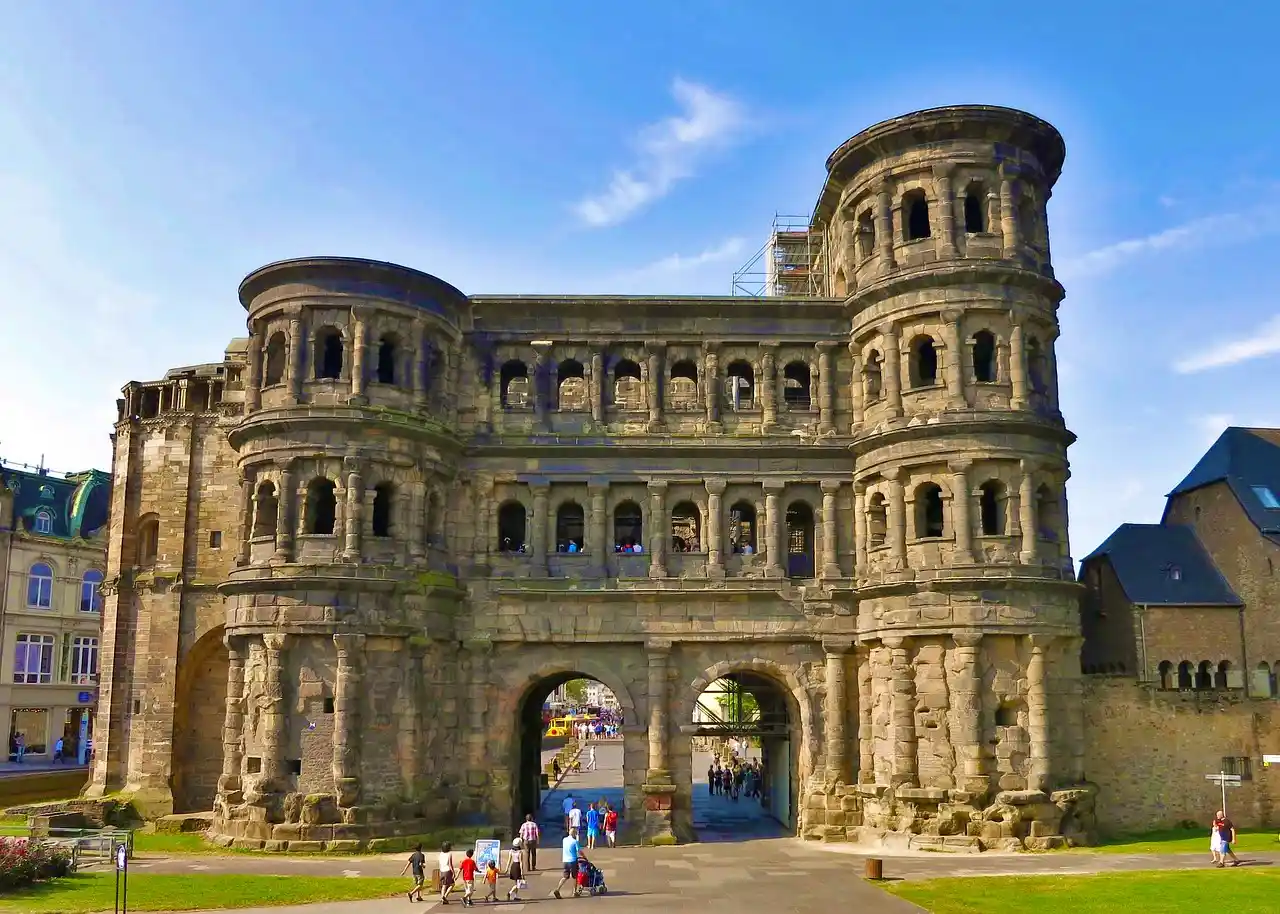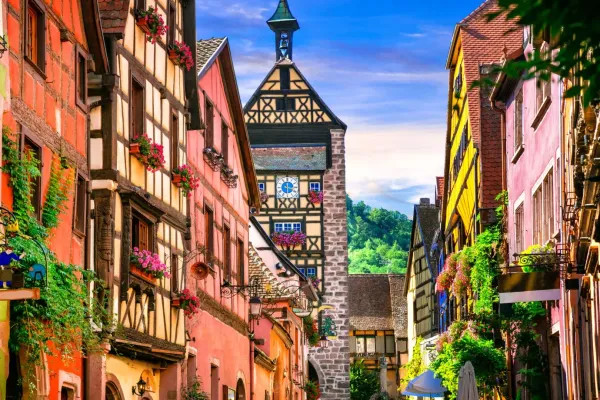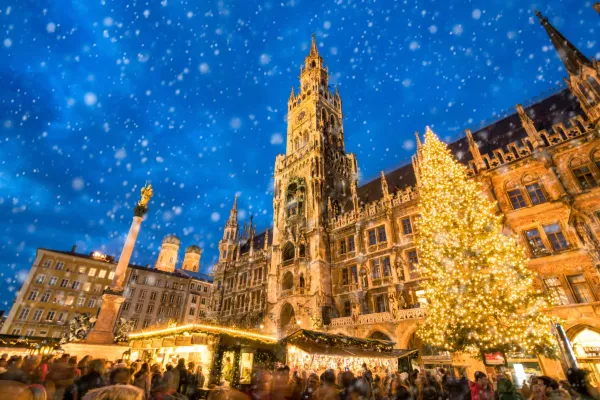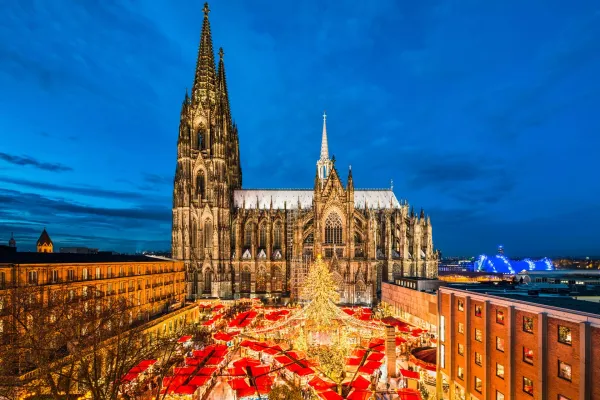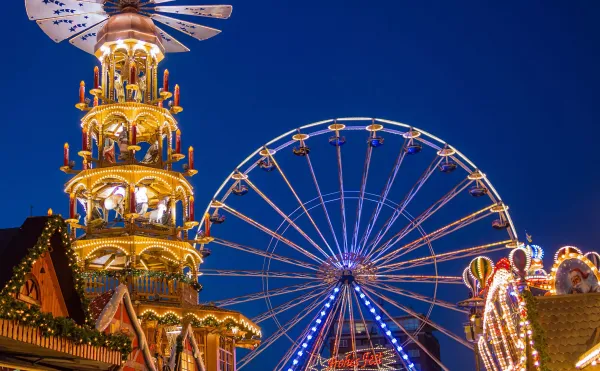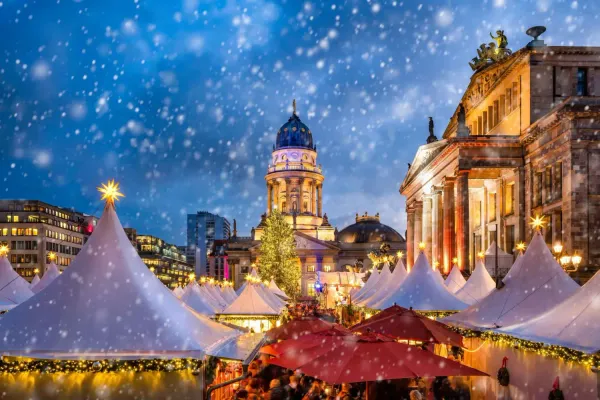Trier is a beautiful city located in southwestern Germany. It is the oldest city in the country and has a rich history dating back to the Roman Empire. There are many tourist attractions in Trier that are worth visiting. Here are some of the best places to see when you are in town.
1. Visit the Porta Nigra
Porta Nigra is a large Roman city gate located in Trier Germany. The name "Porta Nigra" comes from the Latin word for "black", and refers to the dark color of the sandstone that the gate is made from.
This imposing structure is one of the best-preserved Roman monuments in all of Germany and has been designated as a UNESCO World Heritage Site. Visitors can explore the Porta Nigra on their own, or take a guided tour to learn more about its history and significance.
No matter how you choose to experience it, a visit to Porta Nigra is sure to be a memorable one. Read on to find out more about this fascinating landmark.
The Porta Nigra was built between 186 and 200 AD, during the reign of Emperor Augustus. At that time, Trier was known as Augusta Treverorum and was an important city in the Roman Empire. The Porta Nigra served as one of the main entrances into the city and would have been an imposing sight for visitors and residents alike.
The most striking feature of the Porta Nigra is its size; at 30 meters (98 feet) tall and 18 meters (59 feet) wide, it's hard to miss! The structure is made up of three stories, each with its own arched entranceway.
The first story is made up of 16 columns, while the second story has eight columns. The third story is relatively simple in design, with two rows of windows flanking a central opening. A fourth story was originally planned but never completed due to financial constraints.
If you're interested in learning more about the history of this incredible monument, be sure to take a guided tour when you visit. Tours are conducted in both German and English and last around 45 minutes.
You'll learn all about how the Porta Nigra was built, why it's so significant, and what life would have been like for residents during Roman times.
Read also: 12 Best Favorite Places to Visit in Mainz, Germany
2. Visit the Trier Saint Peter's Cathedral
This charming city is home to a number of well-preserved Roman ruins, as well as the majestic Trier Saint Peter's Cathedral. The cathedral, which dates back to the 13th century, is a must-see for any traveler to Trier. Here's a look at this beautiful structure and what you can expect to see on your journey there.
The cathedral is home to a number of important works of art, including a reliquary said to contain the bones of Saint Peter. The cathedral also has a beautiful rose window and an elaborately carved pulpit.
When visiting Trier Saint Peter's Cathedral, be sure to take some time to explore the surrounding area. The cathedral is located in the heart of Trier's Old Town, which is full of historic buildings and charming cobblestone streets. There are also a number of great restaurants and cafes in the area, making it the perfect place to grab a bite to eat after exploring the cathedral.
Read also: 10 Must Visit Attractions in Koblenz City, Germany
3. Visit the Trier Imperial Baths Kaiserthermen
If you're looking for a truly unique travel experience, a visit to The Trier Imperial Baths Kaiserthermen in Germany is a must.
These ancient ruins offer a glimpse into the past when the Roman Empire was at the height of its power. Despite being over 1,600 years old, the baths are remarkably well-preserved and provide an awe-inspiring look at a bygone era.
The Trier Imperial Baths were built during the 4th century AD when Trier was the capital of the Roman province of Gaul. At that time, the city was known as Augusta Treverorum and was home to a large number of Roman nobility and military officials.
The baths were constructed using stone from nearby quarries and were heated using a system of underfloor heating (known as a hypocaust). The main bathhouse was over 300 feet long and could accommodate up to 1,600 people at once!
Although the baths are in ruins, there's still plenty to see when you visit. The remains of the hypocaust system are still visible, as are some of the original mosaics that decorated the walls.
In addition, many of the stone carvings and sculptures that adorned the baths have been preserved and are on display in a museum on site. Even if you're not particularly interested in history, The Trier Imperial Baths are definitely worth a visit for their sheer size and scale.
Read also: 10 Best Tourist Attractions in Bad Kreuznach, Germany
4. Visit the Liebfrauenkirche
One of the most popular tourist attractions in Trier is the Liebfrauenkirche or Church of Our Lady. This Gothic church is located in the heart of the city and is definitely worth a visit.
The Liebfrauenkirche was built in the 13th century and is one of the finest examples of Gothic architecture in Germany. It was commissioned by Emperor Frederick II and his wife, Isabella II, as a thank-you to the Virgin Mary for their safe return from the Sixth Crusade. The name "Liebfrauen" means "beloved lady" and refers to Mary as she is often called in the Catholic tradition.
The exterior of the church is fairly plain compared to other Gothic churches, but don't let that fool you—the interior is absolutely stunning. The high ceilings are supported by massive pillars and topped with beautiful stained glass windows. The overall effect is breathtaking and definitely worth seeing if you're in Trier.
Read also: 8 Must-See Towns in Rhineland-Palatinate, Germany
5. Visit the Karl Marx House
In the heart of Trier Germany lies a small, unassuming house on Brückenstrasse. This is the Karl Marx House, the birthplace of one of history's most influential thinkers. Today, the house is a museum dedicated to the life and work of Karl Marx.
Here, visitors can learn about Marx's formative years, his political ideology, and how his ideas shaped the world as we know it today.
Karl Marx was born in Trier in 1818. His father, Heinrich Marx, was a successful lawyer who ensured that his son received a comprehensive education. Karl attended the Trier Gymnasium, where he excelled in ancient languages.
He then went on to study at the Universities of Bonn and Berlin. It was during his time at university that Marx began to develop his interest in philosophy and politics.
From Marx's early years to the development of his Marxist ideology, visitors will come away from this museum with a greater understanding of both Karl Marx and his impact on the world.
Read also: 10 Best Places to Visit in Cologne, Germany
6. Visit the Trier Amphitheater
This ancient structure was once used for gladiatorial games and public executions, and today it stands as a reminder of the country's rich history. Located in the city of Trier, the amphitheater is just a short walk from the city center and is easily accessible by public transportation.
Once you arrive, you'll be able to explore the ruins of this 2,000-year-old structure. As you walk through the ancient stone seats, imagine what it would have been like to witness a public execution or a gladiator battle. The amphitheater is also surrounded by a beautiful park, so be sure to take some time to stroll around and enjoy the scenery.
If you're interested in learning more about the history of the amphitheater, there are several guided tours available. These tours are led by knowledgeable guides who will share stories and facts about this fascinating piece of architecture.
7. Visit the Electoral Palace
The Electoral Palace, built in the late 17th century, is a beautiful Baroque-style building that was once the home of the Prince-Electors of Trier. Today, it houses a museum with exhibits on the history of the building and the city of Trier. If you're ever in the area, be sure to add this to your list of places to see!
The building has two main wings, which are connected by a central section that houses the grand staircase. The exterior is decorated with ornate sculptures and reliefs, while the interior is lavishly appointed with paintings, tapestries, and furniture from the 17th and 18th centuries.
The Electoral Palace Museum covers three floors with exhibits on the history of both the building and the city of Trier. On the ground floor, you can see how the rooms would have been used during different periods in history.
On the first floor, there are exhibits on religious art from medieval times to the modern day, as well as exhibits on everyday life in Trier from ancient times to today. There is also a section on archaeology with finds from Roman settlements in Trier.
On the second floor, you can see how fashions have changed over time with exhibits on clothing and textiles from different periods. There is also an exhibit on coins and medals from Trier's past, as well as rotating temporary exhibitions.
If you're looking for a unique experience when visiting Germany, be sure to add The Electoral Palace Museum in Trier to your list!
8. Visit the City Museum Simeonstift
If you're ever feeling stuck in a rut, creatively speaking, a day trip to the City Museum Simeonstift Trier in Germany may be just what you need. This unique museum is full of interactive exhibits and installations that are sure to jumpstart your creative juices.
The museum is housed in a former Benedictine monastery that was founded in 882 AD. The monastery was dissolved in the late 18th century, and the building has since been used as a city hall, a hospital, and a school. The City Museum Simeonstift Trier opened its doors to the public in 2009.
One of the highlights of the City Museum Simeonstift Trier is the interactive 18th-century pharmacy exhibit. This exhibit allows visitors to explore what life was like for pharmacists during this time period.
Visitors can also play dress-up in historical costumes, including those of a medieval knight or an 18th-century lady.
9. Visit St. Matthias Abbey
When most people think of Trier Germany, the first thing that comes to mind is the city's famous Roman ruins. And while the ruins are definitely worth a visit, Trier has so much more to offer—including the hidden gem of St. Matthias' Abbey.
St. Matthias' Abbey was founded in the 11th century by a Benedictine monk named Egbert. The abbey quickly became a center of learning and culture, attracting some of the most talented minds of the day. Over the centuries, the abbey went through its share of ups and downs, but it remains an active monastery to this day.
The abbey is open to visitors from 9 am to 5 pm every day except Sunday (when it is reserved for worship). When you enter, you'll be struck by the abbey's simple beauty. The main church is decorated with intricate carvings and stained glass windows, while the adjoining cloister is a peaceful oasis in the midst of the city.
Be sure to also explore the abbey's library, which contains over 200,000 books and manuscripts—including some dating back to the 12th century!
10. Visit Trier Cathedral Museum
The Cathedral Museum is often overlooked by tourists who flock to see the more famous sights such as the Porta Nigra, but those who take the time to visit are richly rewarded.
The Trier cathedral was built in the early 13th century and served as the seat of the Archbishop of Trier for centuries. In 1802, when Napoleon Bonaparte invaded Germany, he declared that all church property belonged to the state. As a result, many of the treasures of the Trier cathedral were confiscated and sold.
Fortunately, some of these treasures made their way back to Trier after Napoleon's defeat, and they form the core of the Cathedral Museum's collection. The museum itself was established in 1886 and has been housed in its current location since 1896.
The Cathedral Museum contains a wide variety of religious artifacts, including paintings, sculptures, and tapestries. One highlight is the "Tombstone of Richarius," which dates back to 1230 and is one of the earliest examples of Gothic art in Germany. Other notable works include a painting of Saint Christopher from 1420 and a beautiful 15th-century tapestry depicting scenes from the life of Christ.
The museum also contains a number of interesting items that were used in everyday life at the cathedral, such as vestments and silverware. Visitors can even see one of the original 12th-century foundation stones that were used to build the cathedral.
Conclusion:
The city of Trier is a beautiful place to visit, and these are some of the best tourist attractions in the area. With its well-preserved Roman ruins, charming old buildings, and lovely river scenery, this city has something to offer tourists of all ages.
If you get the chance, be sure to visit this charming German city and check out all it has to offer.
Hotel Accommodation in Trier
If you're planning a trip to Trier and are looking for hotels, here are some of our top picks!
Mercure Hotel - Nestled in the historic city of Trier in Germany lies Mercure Hotel Trier Porta Nigra, a premier hotel that offers travelers the finest in luxurious accommodations.
With its grand architecture and stunning facades, Mercure Hotel Trier Porta Nigra is an architectural masterpiece that invites guests to embark on a journey into the past.
A blend of modern design and classic elegance, Mercure Hotel Trier Porta Nigra ensures your comfort with meticulously-appointed rooms, unparalleled customer service, and a variety of onsite amenities that are sure to exceed all expectations.
Address: Porta-Nigra-Platz 1, 54292 Trier, Germany
Phone: +4965127010
Hotel Porta Nigra - Set in the picturesque city of Trier, this hotel offers visitors the perfect opportunity to explore both the bustling urban life and the tranquil natural surroundings that make this region so special.
Offering a wide range of amenities and services, as well as top-of-the-line accommodation, Hotel Porta Nigra is on top of the best hotels near Porta Nigra.
Address: Paulinstraße 7, 54292 Trier, Germany
Website: https://www.hotel-porta-nigra.de/
Phone: +4965125939
Schroeders City Style Hotel - is one of the most popular hotels in Germany Trier. With a prime location in the heart of the city and top-of-the-line amenities, Schroeders has become a destination for travelers from all over the world.
Boasting plush beds, free high-speed WiFi, a delicious breakfast buffet, and breathtaking views of Trier's cobblestone streets, Schroeders is truly a jewel among hotels in this charming German city.
Address: Johannisstraße 16, 54290 Trier, Germany
Website: https://www.schroedershotels.com/
Phone: +4965199499610
ibis Styles Hotel - is the perfect destination for travelers looking for a unique and upscale experience. With its unique blend of modern and classic design elements, Schroeders offers guests the chance to escape to a little piece of European luxury right here in Germany Trier.
Featuring impeccably decorated rooms with floor-to-ceiling windows that provide stunning views of the city, as well as carefully designed public spaces complete with cozy nooks for reading or browsing through a magazine, Schroeders truly captures the essence of contemporary style.
Address: Metzelstraße 12, 54290 Trier, Germany
Phone: +49651994920
Hotel Blesius Garten - Hotel Blesius Garten attracts visitors from all over the world who are looking for a relaxing and comfortable stay. From its contemporary rooms to its extensive on-site spa, this elegant hotel is an excellent choice for those seeking a luxurious escape in the beautiful Trier.
Address: Olewiger Str. 135, 54295 Trier, Germany
Website: http://www.blesius-garten.de/
Phone: +4965136060
Hotel Park Plaza Trier - Hotel Park Plaza Trier is the ultimate destination for discerning travelers visiting the city. This luxurious hotel provides spacious rooms and state-of-the-art amenities, ensuring that guests can relax and unwind in comfort and style.
Address: Nikolaus-Koch-Platz 1, 54290 Trier, Germany
Website: http://www.parkplaza-trier.de/
Phone: +4965199930


